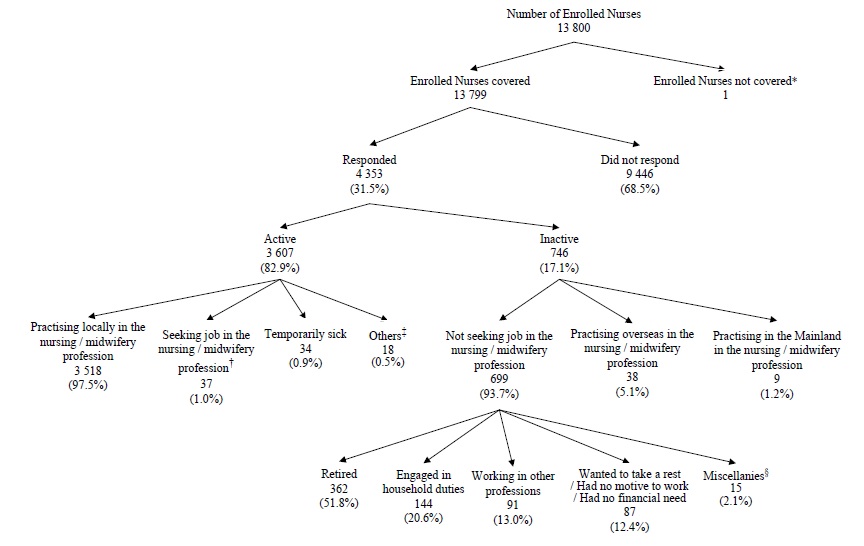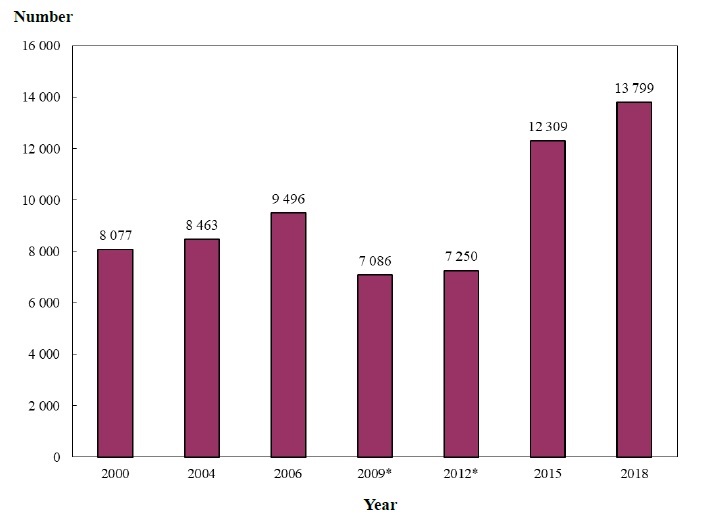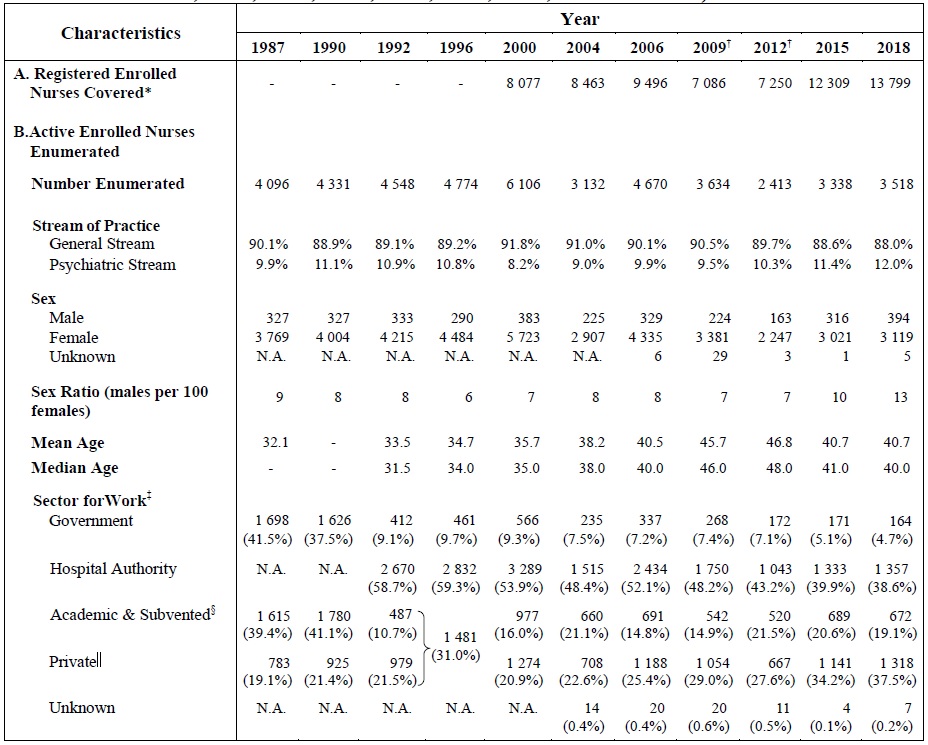Statistics
2018 Health Manpower Survey
Summary of the Characteristics of Enrolled Nurses Enumerated
I. Types of Enrolled Nurses Covered
1.1 The enrolled nurses covered in the 2018 Health Manpower Survey on Enrolled Nurses (HMS-EN) were nursing personnel enrolled in any part of the roll under the Nurses Registration Ordinance (Chapter 164) as at the survey reference date of 31 August 2018, with exclusion of those subsequently found to have passed away on or before the survey reference date.
1.2 The number of enrolled nurses covered was 13 799.
1.3 Of the 13 799 enrolled nurses covered, 4 353 responded to the HMS-EN, giving an overall response rate of 31.5%. Among the respondents, 3 607 (82.9%) were economically active 1,2 (active) in the local nursing / midwifery profession and 746 (17.1%) were economically inactive 1,3 (inactive) in the local nursing / midwifery profession (Chart A).
1.4 Of the 3 607 active enrolled nurses enumerated, 3 518 (97.5%) were practising in the local nursing / midwifery profession, 37 (1.0%) were seeking jobs, 34 (0.9%) were having temporary sickness, and 18 (0.5%) believed that work was not available, were waiting to take up a new job in the local nursing / midwifery profession, starting business in the local nursing / midwifery profession or expecting to return to their original jobs in the local nursing / midwifery profession during the 30 days before the survey. The survey results presented in paragraph 1.6 below were based on 3 518 responding enrolled nurses who were practising in the local nursing / midwifery profession as at 31 August 2018. The percentages present below may not add up to 100% due to missing responses or rounding.
1.5 Of the 746 inactive enrolled nurses, 38 (5.1%) reported practising overseas, nine (1.2%) reported practising in the Mainland and 699 (93.7%) reported not seeking job in the local nursing / midwifery profession during the 30 days before the survey (Chart A). Among the 699 inactive enrolled nurses who reported not practising in Hong Kong and not seeking jobs in the local nursing / midwifery profession, the main reasons reported for not seeking jobs included: 362 (51.8%) were retired, 144 (20.6%) were engaged in household duties, 91 (13.0%) were working in other professions and 87(12.4%) wanted to take a rest / had no motive to work / had no financial need.
1.6 Among the 3 518 active enrolled nurses enumerated who were practising in the local nursing / midwifery profession, 3 095 (88.0%) were in the general stream and 423 (12.0%) were in psychiatric stream.
1 In the survey, the criteria used in defining economically active / inactive followed those recommended by the International Labour Organization, which are also being used by the Census and Statistics Department in Hong Kong.
2 "Economically active" enrolled nurses comprised all "employed" and "unemployed" enrolled nurses. "Employed" enrolled nurses referred to those enrolled nurses practising in the nursing / midwifery profession in Hong Kong during the survey period, while "unemployed" enrolled nurses referred to those enrolled nurses who (a) were not practising in the local nursing / midwifery profession during the survey period; (b) had been available for work during the seven days before the survey; AND (c) had sought work in the local nursing / midwifery profession during the 30 days before the survey.
3 "Economically inactive" enrolled nurses comprised the enrolled nurses who were not practising in the nursing / midwifery profession in Hong Kong during the survey period, excluding those who had been on leave during the survey period and who were "economically active" but "unemployed".
Chart A : Activity Status of Enrolled Nurses Covered

| Note: | * | Figure refers to the number of enrolled nurses subsequently found to have passed away on or before 31 August 2018. |
| † | Figure refers to the number of responding enrolled nurses who (a) were not practising in the nursing / midwifery profession in Hong Kong during the survey period; (b) had been available for work during the seven days before the survey; AND (c) had sought work in the nursing / midwifery profession during the 30 days before the survey. | |
| ‡ | Figure refers to the number of responding enrolled nurse who (a) were not practising in the nursing / midwifery profession in Hong Kong during the survey period; AND (b) believed that work was not available, were waiting to take up a new job, starting business at subsequent date or expecting to return to their original jobs in the local nursing / midwifery profession during the 30 days before the survey. Some of them had been available for work in the local nursing / midwifery profession during the seven days before the survey. | |
| § |
Figure refers to the number of responding enrolled nurses who reported emigrated, undertaking study, etc. Percentages may not add up to 100% due to rounding. |
1.7 Five active enrolled nurses did not indicate the gender. Among the remaining 3 513 active enrolled nurses enumerated who were practising in the local nursing / midwifery profession, 394 (11.2%) were male and 3 119 (88.8%) were female, giving an overall sex ratio (males per 100 females) of 13. Apart from 59 enrolled nurses who did not indicate their age, the median age of the remaining 3 459 active enrolled nurses enumerated was 40.0 years. The median age of the active female enrolled nurses enumerated was 41.0 years and that of their male counterparts was 36.0 years.
1.8 The responding enrolled nurses were requested to indicate the characteristics of their main jobs 4. Distribution by sector for the main job of those enumerated showed that 1 357 (38.6%) active enrolled nurses enumerated were working in the Hospital Authority, followed by 1 318 (37.5%) in the private sector, 650 (18.5%) in the subvented sector, 164 (4.7%) in the Government and 22 (0.6%) in the academic sector.
4 Main jobs referred to the jobs in which the enrolled nurses had spent most of their working time.
1.9 The median age of the active enrolled nurses enumerated was the highest for those working in the Government (47.0 years), followed by the subvented sector (46.0 years), the Hospital Authority (41.0 years), the academic sector (36.0 years) and the private sector (33.5 years).
1.10 Of the 3 518 active enrolled nurses enumerated, 726 (20.6%) spent most of their working time on residential care, followed by 499 (14.2%) on geriatrics, 487 (13.8%) on medicine, 386 (11.0%) on surgery, 344 (9.8%) on ambulatory care / outpatients, 285 (8.1%) on mental health / psychiatry / addiction treatment, 153 (4.3%) on rehabilitation, 115 (3.3%) on working as visiting nurse, 94 (2.7%) on paediatrics and 66 (1.9%) on public health.
1.11 The median number of hours of work (excluding meal breaks) per week of the 3 518 active enrolled nurses enumerated was 44.0 hours. Among them, 315 (9.0%) were required to undertake on-call duty (excluding normal duty), with median number of 8.0 hours of on-call duty (excluding normal duty) per week.
1.12 In terms of earliest basic qualification in nursing / midwifery profession, of the 3 518 active enrolled nurses enumerated, 2 897 (82.3%) had received Student / Pupil Nurse Training, 563 (16.0%) held Higher Diploma and 31 (0.9%) held Bachelor’s Degree as their earliest basic qualification.
1.13 Of the 3 518 active enrolled nurses enumerated, 1 867 (53.1%) had received / were receiving additional training after obtaining their earliest basic qualification. Of the 1 867 active enrolled nurses enumerated with additional training, 725 (38.8%) held Certificate, 380 (20.4%) held Higher Diploma, 359 (19.2%) held Bachelor’s Degree as the highest qualification, and 139 (7.4%) had not yet completed the additional training.
1.14 Of the 1 867 active enrolled nurses enumerated who had received / were receiving additional training after obtaining their earliest basic qualification, 1 228 (65.8%) had received / were receiving training in one field only. Among them, 267 (21.7%) were trained / receiving training in general nursing, 142 (11.6%) in enrolled nurse to registered nurse conversion course, 120 (9.8%) in mental health nursing, 101 (8.2%) in geriatric nursing, 92 (7.5%) in emergency / first aid nursing, 71 (5.8%) in community health and 48 (3.9%) in surgical nursing.
1.15 For the active enrolled nurses enumerated who had indicated more than one field of additional training, the cumulative total number of active enrolled nurses enumerated by the field of additional training obtained was 3 046. Among these 3 046, 455 (14.9%) had received / were receiving additional training in general nursing, 313 (10.3%) in geriatric nursing, 225 (7.4%) in emergency / first aid nursing, 203 (6.7%) in mental health nursing, 189 (6.2%) in community health, 150 (4.9%) in enrolled nurse to registered nurse conversion course, 144 (4.7%) in surgical nursing and 129 (4.2%) in hospice nursing.
1.16 Regarding Continuing Nursing Education (CNE) / Post-registration Education in Midwifery (PEM), 2 644 (75.2%) of the active enrolled nurses enumerated reported that they had participated in CNE / PEM in 2018, 817 (23.2%) reported no participation in any CNE / PEM and 57 (1.6%) did not report whether they had participated in any CNE / PEM or not. Among the 2 644 active enrolled nurses enumerated who had participated in CNE / PEM, the distribution of CNE / PEM points / hours attained in the past 12 months was : 1 to 5 points / hours (21.1%), 6 to 10 points / hours (22.8%), 11 to 15 points / hours (19.3%), 16 to 20 points / hours (11.2%) and more than 20 points / hours (25.6%).
II. Trend Analysis
2.1 Comparison of findings of the 2018 HMS-EN with those surveys conducted on or before 2004 should be made with caution as the survey methods and reference date had been changed 5.
2.2 Between 2000 and 2018, the numbers of enrolled nurses covered in the surveys were in the range from 7 086 to 13 799. The proportion of enrolled nurses in the general stream remained stable (from 88.0% – 91.8%) between 1987 and 2018 (Chart B & Table A).
2.3 The sex ratio (males per 100 females) of active enrolled nurses enumerated ranged from 6 to 13 between 1987 and 2018 (Table A).
2.4 The median age of the active enrolled nurses enumerated increased from 31.5 years in 1992 to 40.0 years in 2018.
2.5 From 1987 to 1990, the largest proportion of active enrolled nurses enumerated worked in the Government and the subvented sectors, which altogether accounted for about 80% and the remaining enrolled nurses worked in the private sector. Since its setup in 1991, the Hospital Authority has been the largest employer covering around 50% of active enrolled nurses enumerated. The proportion of active enrolled nurses enumerated working in the private sector increased from 20.9% in 2000 to 37.5% in 2018 (Table A).
5 As the 2009 and 2012 Health Manpower Survey only aimed at covering all enrolled nurses who had to renew their practising certificates in 2009 and 2012, enrolled nurses who did not need to renew practising certificate in 2009 and 2012 were excluded from the survey.
Figure of 2000 refers to the number of enrolled nurses enrolled with the Nursing Council of Hong Kong and who were holding valid practising certificates as at 1 July 2000, whereas the figures of 2004, 2006, 2015 and 2018 refer to that as at 31 August of the respective years and the figures of 2009 and 2012 refer to the number of enrolled nurses enrolled with the Nursing Council of Hong Kong as at 31 August of the respective years and had to renew their practising certificates in respective years. Figures of 2018 refer to the number of enrolled nurses enrolled with Nursing Council of Hong Kong as at 31 August 2018 with exclusion of those who were subsequently found to have passed away on or before the survey reference date.
Chart B : Number of Enrolled Nurses Covered by Year (2000, 2004, 2006, 2009, 2012, 2015 and 2018)

| Note: | * | As the 2009 and 2012 Health Manpower Survey only aimed at covering all enrolled nurses who had to renew their practising certificates in 2009 and 2012, enrolled nurses who did not need to renew practising certificate in 2009 and 2012 were excluded from the survey. |
| Figure of 2000 refers to the number of enrolled nurses enrolled with the Nursing Council of Hong Kong and who were holding valid practising certificates as at 1 July 2000, whereas the figures of 2004, 2006, 2015 and 2018 refer to that as at 31 August of the respective years and the figures of 2009 and 2012 refer to the number of enrolled nurses enrolled with the Nursing Council of Hong Kong as at 31 August of the respective years and had to renew their practising certificates in respective years. Figures of 2018 refer to the number of enrolled nurses enrolled with Nursing Council of Hong Kong as at 31 August 2018 with exclusion of those who were subsequently found to have passed away on or before the survey reference date. |
Table A : Selected Characteristics of Active Enrolled Nurses Enumerated (1987, 1990, 1992, 1996, 2000, 2004, 2006, 2009, 2012, 2015 and 2018)

| Note: | * | Figure of 2000 refers to the number of enrolled nurses enrolled with the Nursing Council of Hong Kong and who were holding valid practising certificates issued by the Nursing Council as at 1 July 2000, whereas the figures of 2004, 2006, 2015 and 2018 refer to that as at 31 August of the respective years, the figures of 2009 and 2012 refer to the number of enrolled nurses enrolled with the Nursing Council of Hong Kong as at 31 August of the respective years and had to renew their practising certificates in the respective years. Figure of 2018 refers to the number of enrolled nurses enrolled with Nursing Council of Hong Kong as at 31 August 2018 with exclusion of those who were subsequently found to have passed away on or before the survey reference date. |
| † | As the 2009 and 2012 Health Manpower Survey only aimed at covering all enrolled nurses who had to renew their practising certificates in 2009 and 2012, enrolled nurses who did not need to renew practising certificate in 2009 and 2012 were excluded from the survey. | |
| ‡ | In 2004, 2006, 2009, 2012, 2015 and 2018 HMS-EN, the sector refers to the sector for the main job. | |
| § | Academic was not included in the 1987 HMS-EN to 1992 HMS-EN. | |
| ║ | Military was included in the 1987 HMS-EN. Academic was included in the 1990 and 1992 HMS-EN. | |
| There may be slight discrepancy between the sum of individual items and the total due to rounding. | ||
| N.A. | Not applicable | |
| ‘ -’ | Not available |